One of the most common causes of sudden-onset lameness in a horse is an abscess of the hoof. These occur when bacteria invade a horse’s hoof, and the horse becomes lame when the infection reaches the sensitive structures of the foot. Besides showing varying degrees of lameness, a horse with an abscess will be sensitive to hoof testers or percussion and may have lower leg swelling or an increased digital pulse. When it comes to treatment, the hoof abscess may erupt on its own, either from the sole of the hoof or at the coronary band. Otherwise, your vet will pare away the sole to locate and drain the site of infection.
The goal in the treatment of a horse’s hoof abscess is to draw out the infection and keep the area clean to prevent reinfection while the hoof heals. Once you have confirmed the diagnosis with your vet, follow the steps below to put your horse on the road to recovery.
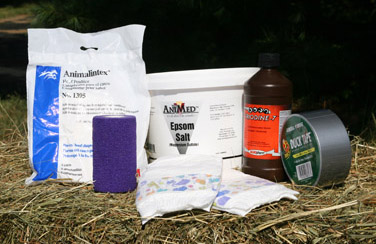 For treatment of a horse’s hoof abscess, you will need a flexible bucket or tub, Epsom salts and poultice pads or iodine. Bandaging materials include sheet cotton or a diaper, elastic bandage and duct tape. For treatment of a horse’s hoof abscess, you will need a flexible bucket or tub, Epsom salts and poultice pads or iodine. Bandaging materials include sheet cotton or a diaper, elastic bandage and duct tape. |
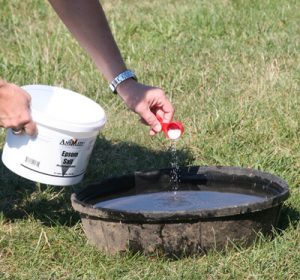 Step 1: Mix Epsom salts in a bucket of warm water. Use enough salts to reach the point of saturation, where no more will dissolve. |
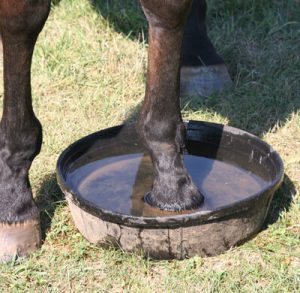 Step 2: Submerge the entire hoof up to the coronary band and soak for 10 minutes. This will help draw out the infection and will encourage the abscess to erupt if it has not already been opened and drained. Step 2: Submerge the entire hoof up to the coronary band and soak for 10 minutes. This will help draw out the infection and will encourage the abscess to erupt if it has not already been opened and drained. |
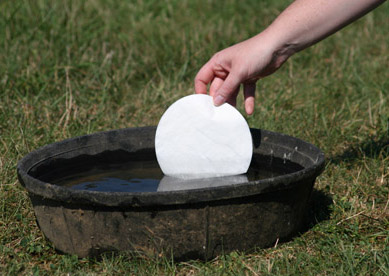 Step 3: Soak a poultice pad in hot water. Step 3: Soak a poultice pad in hot water. |
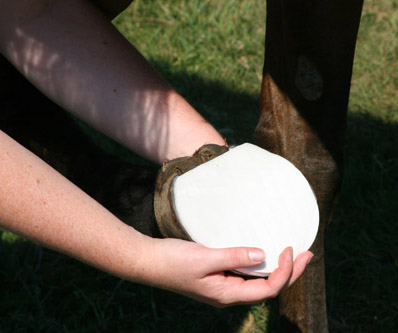 Place the pad over the sole of the hoof. Place the pad over the sole of the hoof. |
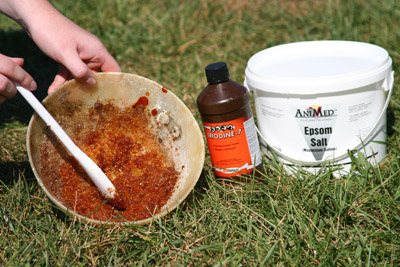 If you do not have any poultice pads, you can make a poultice with Epsom salts and iodine. If you do not have any poultice pads, you can make a poultice with Epsom salts and iodine. |
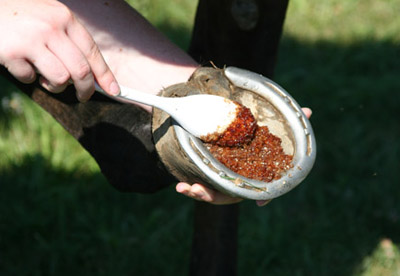 Pack the paste into the hoof so it covers the entire sole. Pack the paste into the hoof so it covers the entire sole. |
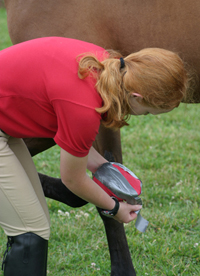 Step 4: Wrap the hoof in a diaper or sheet cotton. Secure the diaper by tightly wrapping it with elastic bandage. Cover the entire bandage with duct tape for durability. If your horse will be turned out or is prone to destroying bandages, you may want to use a hoof boot.
Click here for step-by-step instructions on bandaging a hoof. |
Your horse may be sound in as little as a couple of days. Once the abscess has drained, keeping the hoof protected from dirt and debris is the best way to avoid complications or reinfection. And of course, always consult your vet to help you decide the best course of action.
Further Reading on Treatment of Hoof Abscesses in Horses
◆ Hoof Abscesses and Puncture Wounds
◆ How to Manage and Treat a Hoof Abscess
◆ Causes of Equine Lameness: Foot Abscess
This article about treatment of hoof abscesses first appeared in Horse Illustrated magazine. Click here to subscribe!






the wrap seems to be too high…keep it to just above the cornet band or you may have circulation issues.
Our vet showed us how to wrap it so it would come off easier. They are hard to get off. Good article!
Excellent article! 🙂 Thank you, will print it off and keep it for reference as I have a horse who is very frequently getting abscesses. 🙂
Excellent. Thank you. I have a horse that is lame and it is a suspected abcess but it is not coming to a head. Currently the poultice is on – it is so hard to see him so lame and unsure how long he will be that way. This article has helped me better understand. He is under the care of a vet
The last photo showing the duct taped hoof should be removed. It is absolutely dangerous to have any tape or wrapping around the coronary band. There are plenty of ways to wrap a hoof without going above the coronary band.
This is the best information I have found on the Net. My vet didn’t even offer this alternative. Many thanks.
Great advice!
I’ve been using an Epsom salts soak for years with perfect success in my commercial stable but liked the extra ideas you provide.
So, Jennifer, what other ways are there?
Excellent advice–and it worked!
What if a horse riped it’s inside hoof off and up the side and the front top of skin has holes draining thick pus in the front above the hoif they won’t call vet and have tried everything to get to heal the horse is in a lot of pain and the pain meds aren’t helping And owner won’t call a vet says he has no money but he does
I have an 1800 lb Percheron who abscesses 2x a year. The salt bath has been a chore. Finally, I started using double-bagged freezer bags (2 gal. in my case). I put the bags over his hoof, put the hoof in the rubber bucket and filled the bags. I tied them around his ankle with a simple clothesline about the length of a leash. the bucket is in case the bags leak. He tolerates this method beautifully and stands still for as long as 20 mins (when helped with a bucket of grain and a couple of flakes of hay in front of him. Before, I only got about 5 mins. of standing in the epsom salts before he tipped the bucket over. So much easier!